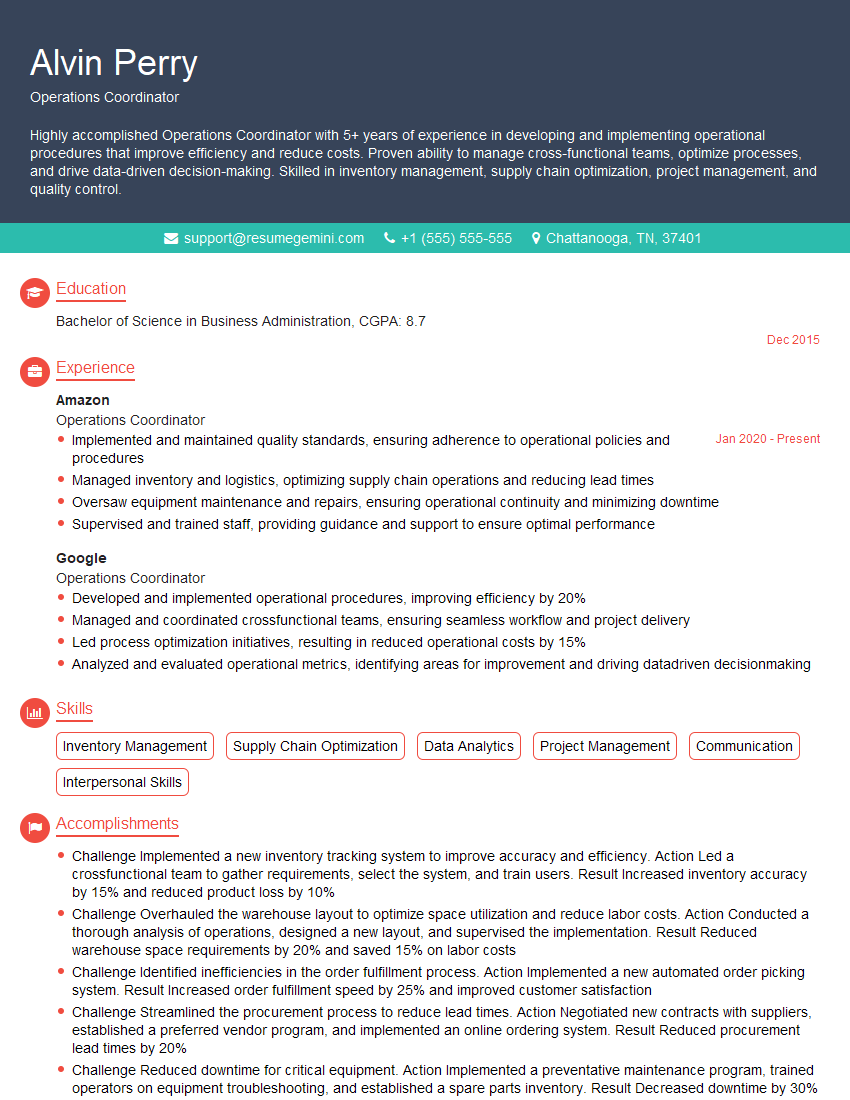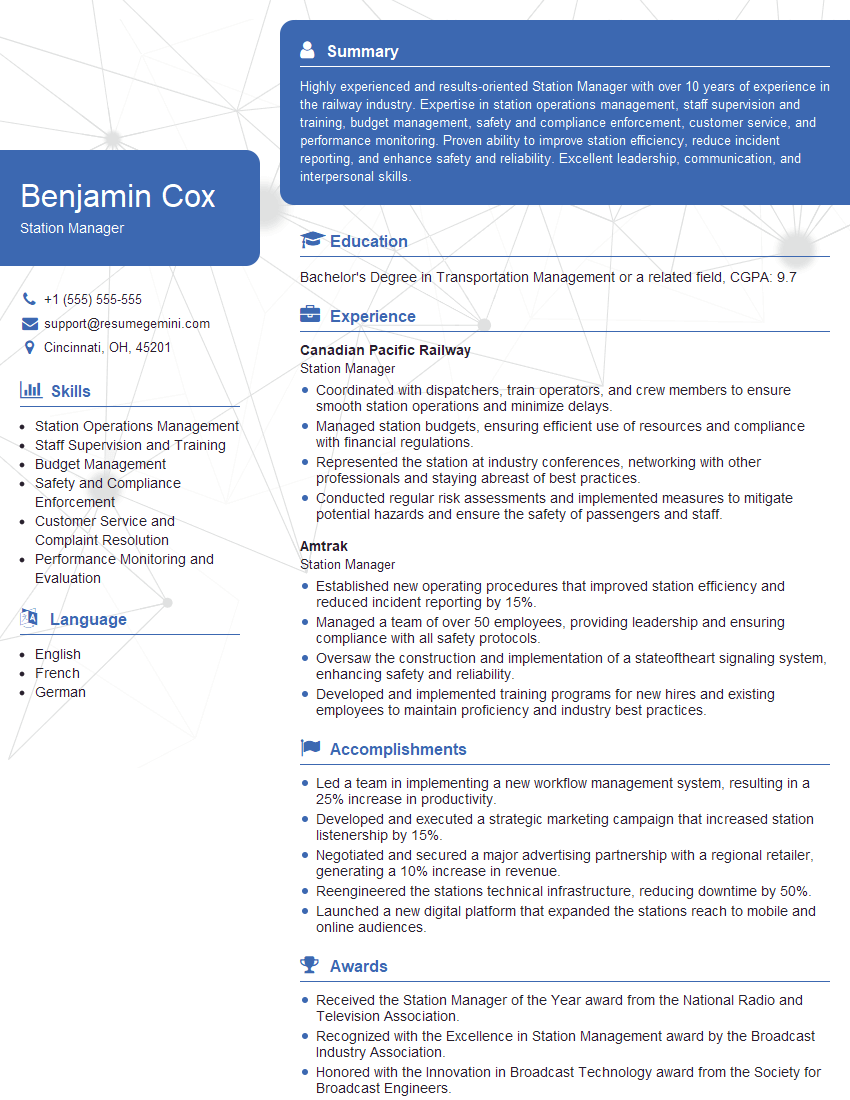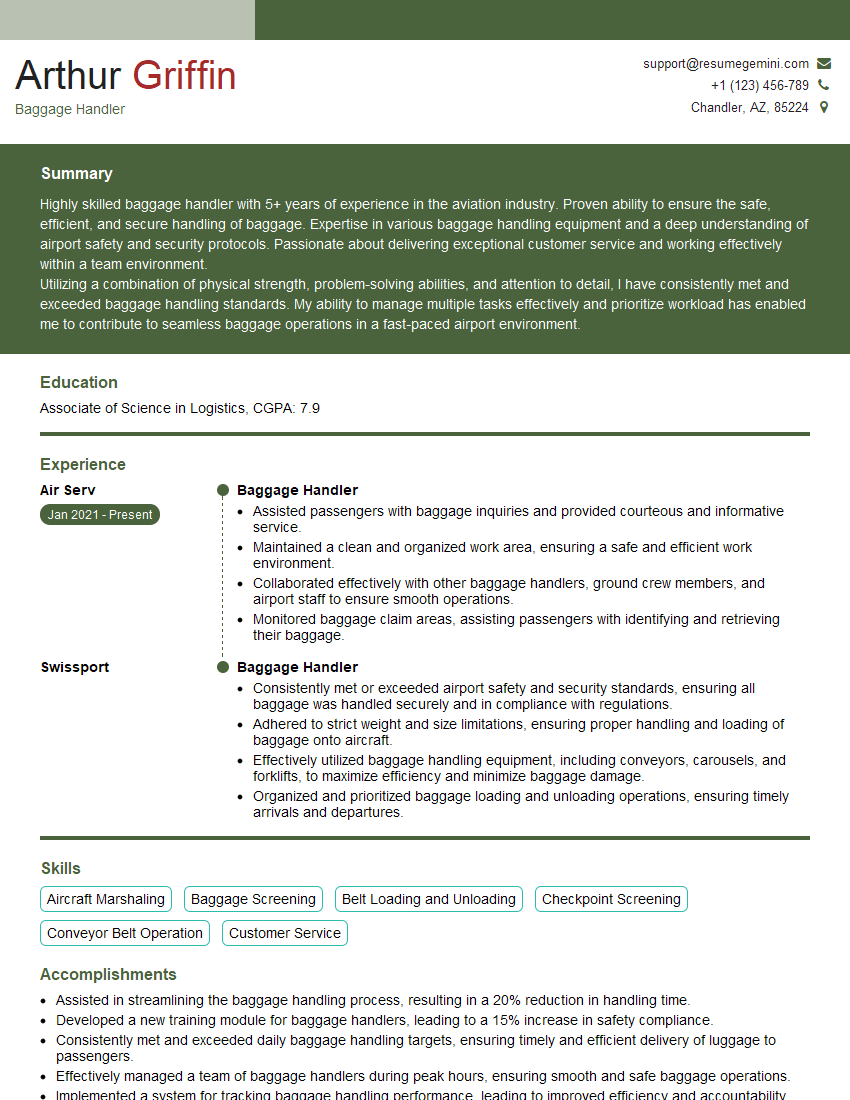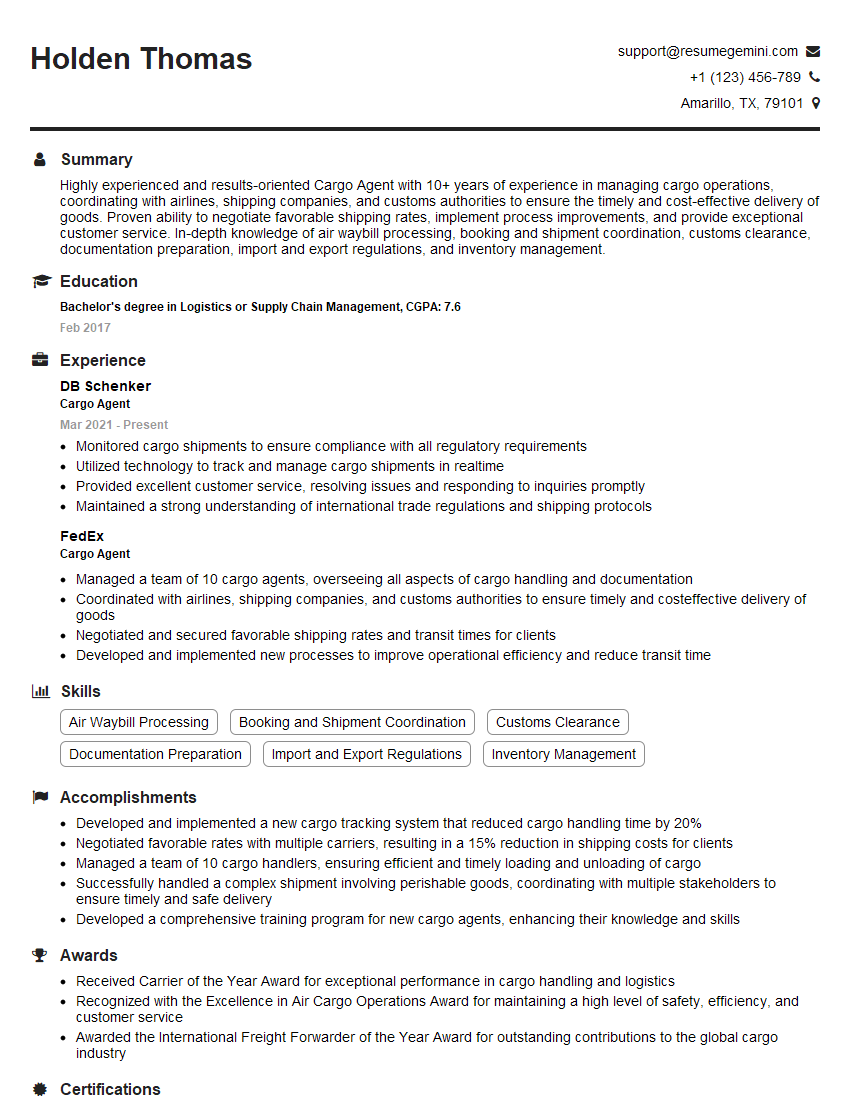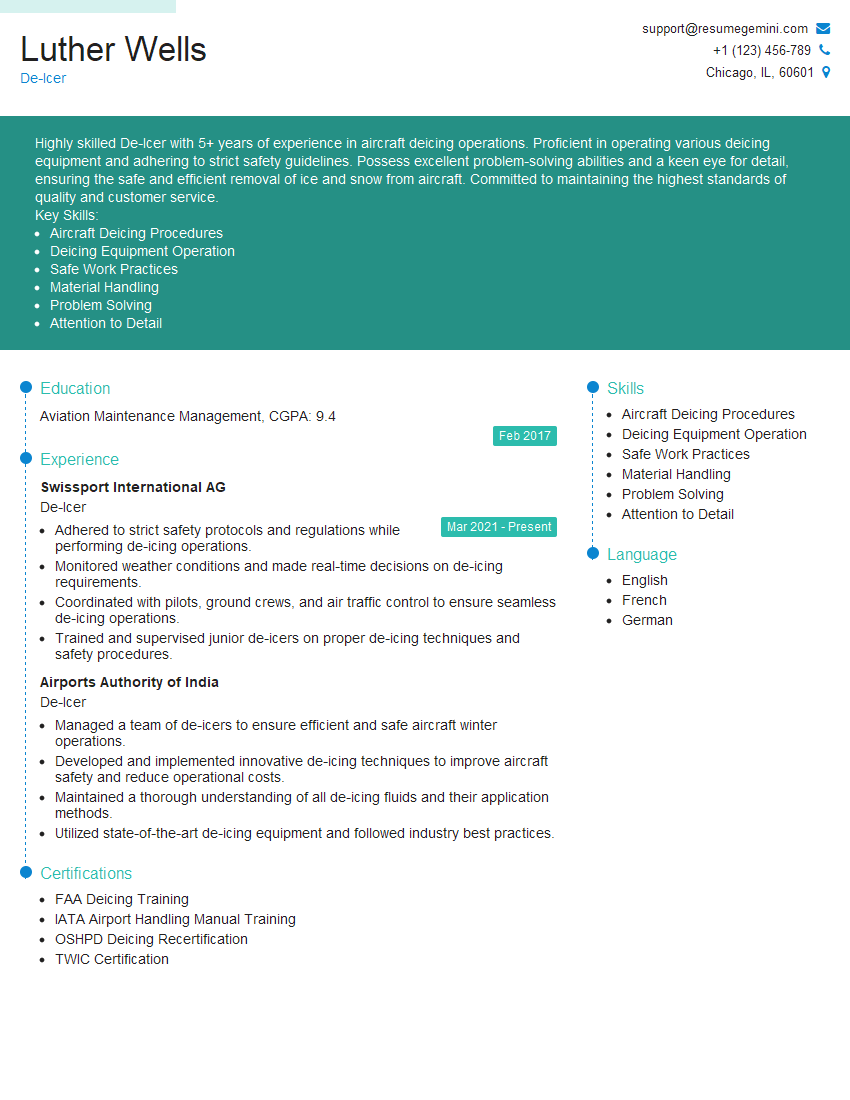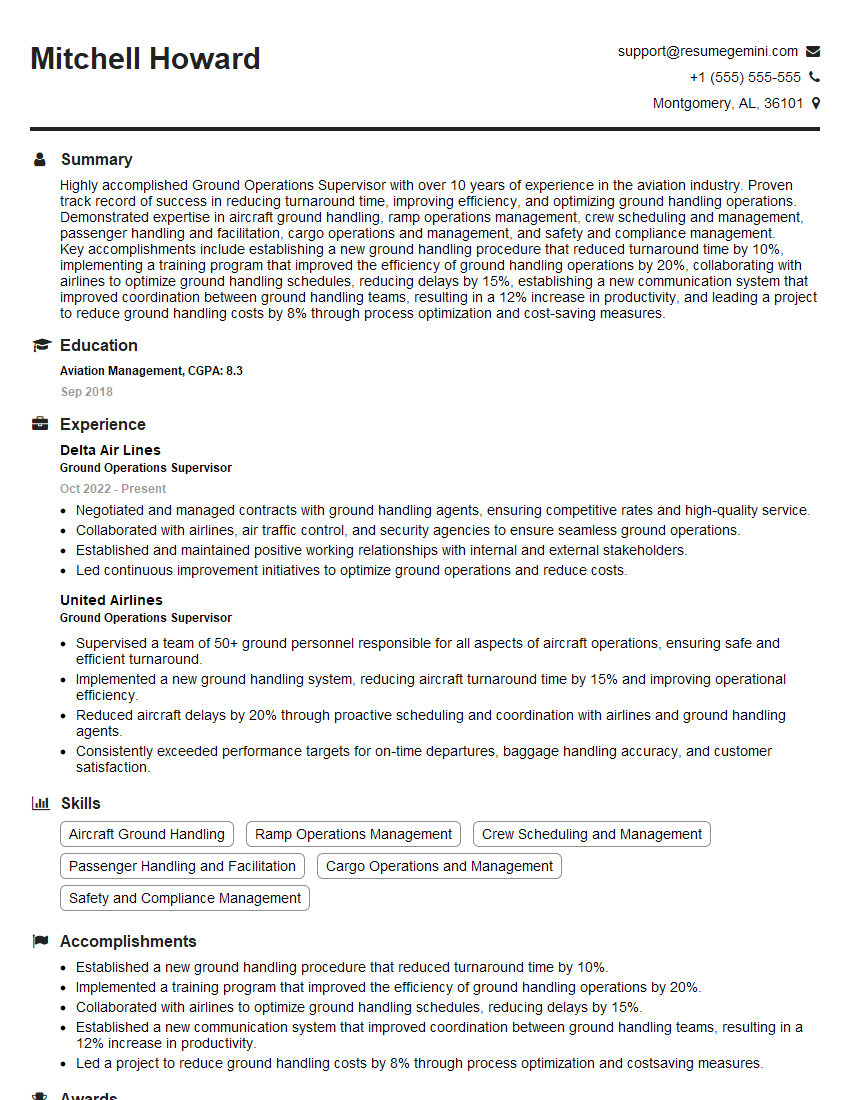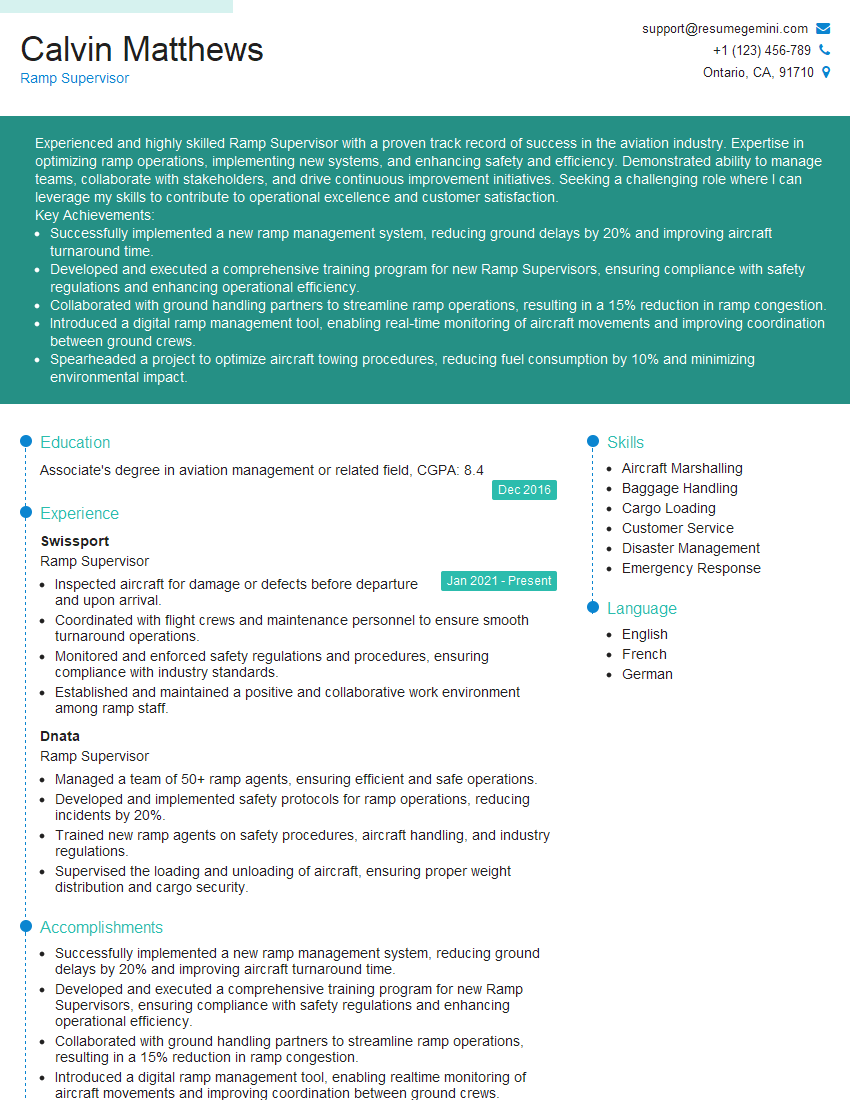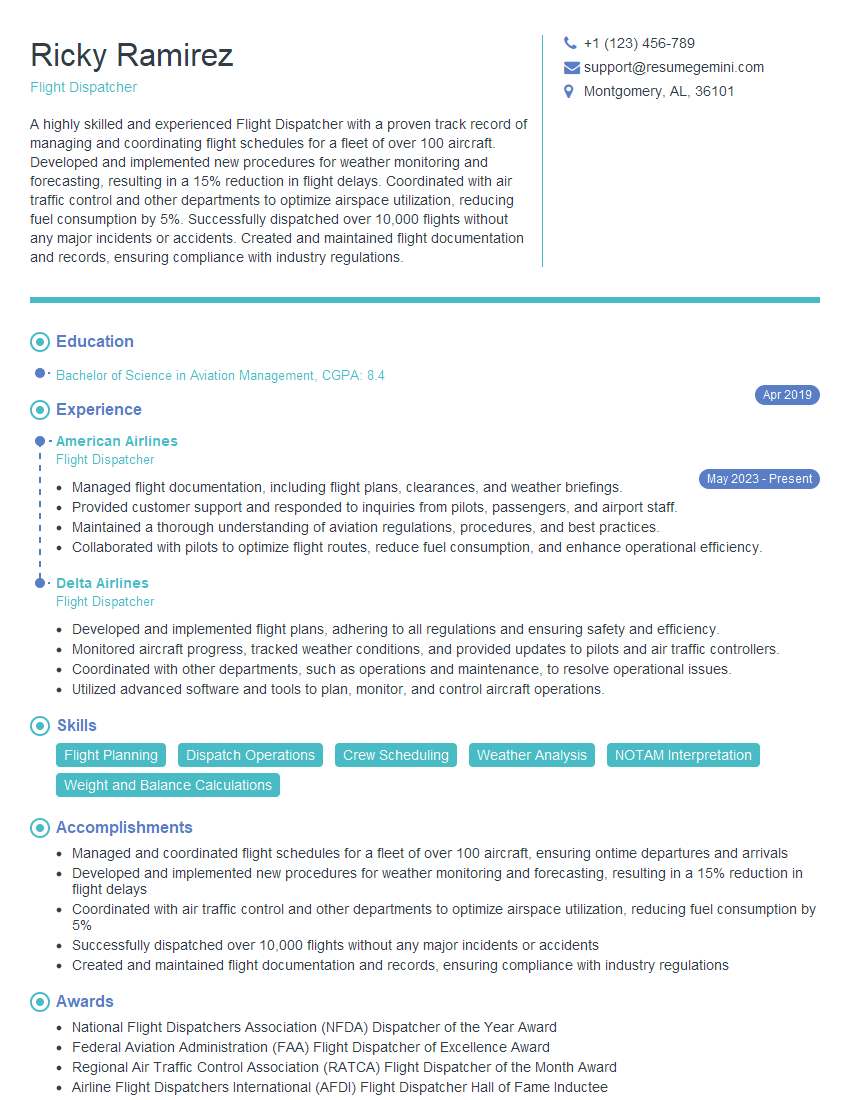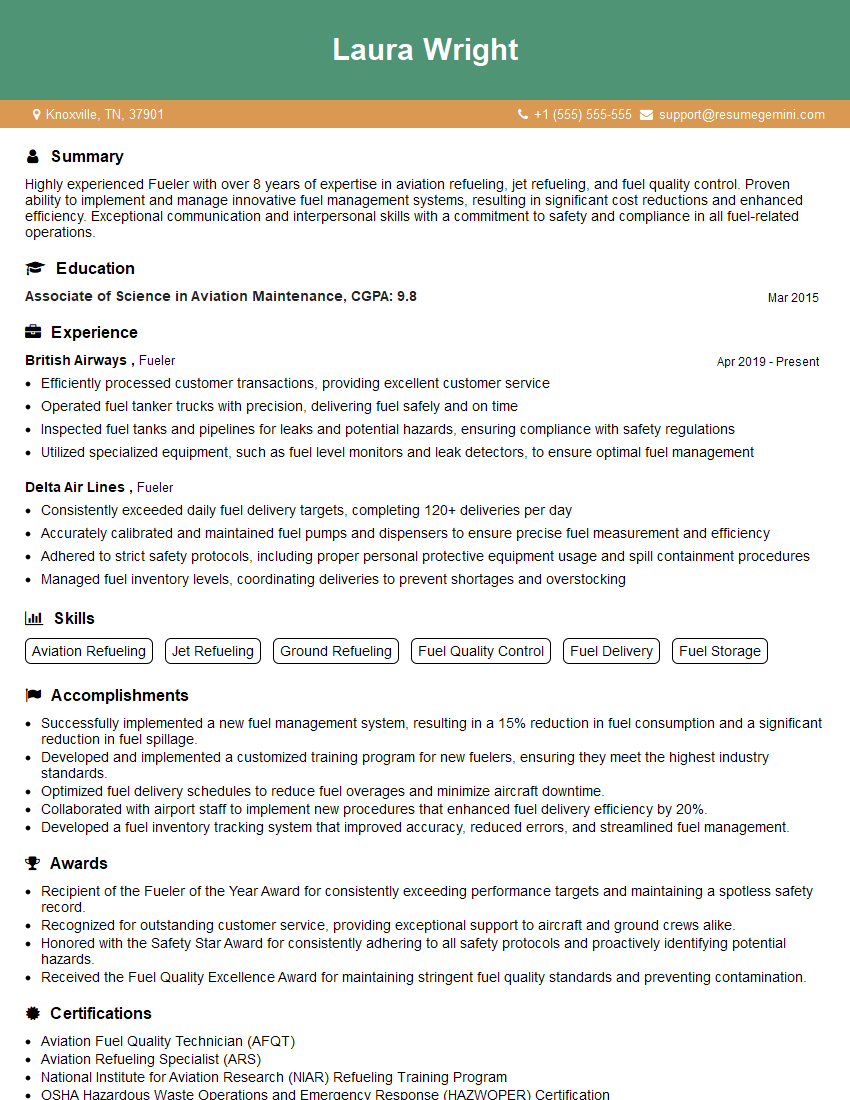Feeling uncertain about what to expect in your upcoming interview? We’ve got you covered! This blog highlights the most important Aviation Ground Operations interview questions and provides actionable advice to help you stand out as the ideal candidate. Let’s pave the way for your success.
Questions Asked in Aviation Ground Operations Interview
Q 1. Describe the process of weight and balance calculations for aircraft.
Weight and balance calculations are crucial for safe and efficient aircraft operation. They ensure the aircraft remains within its certified center of gravity (CG) limits throughout the flight. Improper weight and balance can lead to control difficulties, reduced performance, and even catastrophic failure.
The process involves meticulously calculating the total weight of the aircraft, including its empty weight, passengers, cargo, fuel, and other items. This total weight is then compared to the aircraft’s maximum allowable weight (MAW). Simultaneously, the CG is calculated – the point where the aircraft’s weight is evenly distributed. This must fall within the manufacturer’s specified limits.
This calculation typically involves using a weight and balance computer program or a manual calculation sheet provided by the aircraft manufacturer. Input data includes the weight and location of each item. The program then calculates the total weight and CG location, indicating whether the aircraft is within safe operating limits. If not, adjustments need to be made, like shifting cargo or reducing fuel load, before flight.
Example: Imagine a small aircraft with a MAW of 2,500 kg. After entering the weights of the empty aircraft, passengers, baggage, and fuel, the software indicates a total weight of 2,400kg and a CG within limits. The flight is safe to operate. However, if adding more fuel pushes the total weight above 2,500 kg, or shifts the CG outside the limits, adjustments are needed to ensure safety.
Q 2. Explain the importance of proper aircraft marshalling procedures.
Proper aircraft marshalling is paramount for the safe and efficient movement of aircraft on the ground. Marshallers guide pilots during taxiing, pushback, and engine start, ensuring clear communication and preventing collisions or damage.
The importance lies in minimizing risk. Aircraft are large, powerful machines with limited visibility for the pilot in certain situations. Marshallers provide essential visual guidance, particularly in low-visibility conditions or congested areas. Their hand signals are standardized internationally, ensuring a clear understanding between the marshaller and pilot.
Improper marshalling can lead to accidents – collisions with other aircraft, ground vehicles, or obstacles, as well as damage to the aircraft itself. It also leads to delays and disruptions to the entire airport operation. Moreover, a lack of proper communication can lead to misunderstandings and potential safety risks.
Example: In a busy airport, a marshaller’s clear signals prevent a large aircraft from colliding with a smaller vehicle during pushback. Their precise guidance ensures a smooth, safe maneuver into a tight parking spot, minimizing delays for subsequent flights.
Q 3. How do you ensure the safe and efficient loading and unloading of baggage?
Safe and efficient baggage handling is a critical aspect of ground operations, impacting on-time performance and passenger satisfaction. It involves a structured process from check-in to loading onto the aircraft.
Ensuring safety: This includes using appropriate equipment, such as conveyor belts and baggage carts, to minimize manual handling and the risk of injury. Strict adherence to weight limits for each piece of baggage is crucial to prevent overloading. Baggage handlers undergo regular training on safe lifting techniques and hazard identification. Careful attention is paid to fragile items and hazardous materials.
Ensuring efficiency: Efficient baggage handling requires optimized processes and technology. This includes using barcode scanners and automated baggage sorting systems to track luggage and ensure swift loading. Staffing levels are adjusted according to flight schedules, and communication between different teams is paramount to avoid bottlenecks. Real-time tracking systems alert staff to potential delays or issues.
Example: A well-managed baggage system uses conveyor belts to swiftly move checked bags from check-in to the aircraft. Barcode scanning tracks each bag, reducing the chances of mishandling or misplacing items, leading to satisfied passengers and efficient turnaround times.
Q 4. What are the different types of Ground Support Equipment (GSE) and their functions?
Ground Support Equipment (GSE) is vital for aircraft operations. Different types of equipment play specific roles in maintaining efficiency and safety.
- Pushback tractors: Used to move aircraft away from the gate without the use of the aircraft’s engines, reducing noise and fuel consumption.
- Baggage tractors and carts: Transport baggage between terminals and aircraft.
- Aircraft stairs and passenger boarding bridges: Facilitate passenger boarding and disembarking.
- Fuel trucks: Refuel aircraft before departure.
- Belt loaders: Load and unload baggage and cargo quickly and efficiently.
- De-icing trucks: Remove ice and snow from aircraft during winter operations.
- GPU (Ground Power Units): Provide electrical power to aircraft on the ground.
- Air start units (ASU): Provide compressed air to start aircraft engines.
Example: A pushback tractor safely moves a large aircraft away from the gate, avoiding potential collisions with other aircraft or ground vehicles. A belt loader quickly loads passenger luggage, minimizing delays and improving on-time performance.
Q 5. Describe your experience with dangerous goods handling and regulations.
Dangerous goods handling requires strict adherence to international and national regulations (e.g., IATA regulations). My experience includes thorough training on identifying, classifying, packaging, and documenting dangerous goods. I’m familiar with the use of the IATA Dangerous Goods Regulations manual and the associated paperwork.
This involves understanding the different classes of dangerous goods (explosives, flammables, corrosives, etc.) and their specific handling requirements. Proper documentation is essential, ensuring all shipments are declared correctly. This includes completing shipping papers accurately, labeling packages correctly and verifying that all packaging meets the required standards.
I am proficient in handling emergencies involving dangerous goods, such as spills or leaks, knowing the appropriate safety procedures and emergency response protocols. This includes knowing how to contact emergency services and following the established procedures for containment and cleanup.
Example: I’ve personally handled the safe loading of lithium batteries for transport. This involved verifying the correct packaging, labeling the package according to IATA standards, and ensuring the appropriate documentation was completed before the shipment. I also regularly conduct training sessions for baggage handlers to refresh their knowledge of dangerous goods regulations.
Q 6. How do you handle a situation where a flight is delayed due to ground operations issues?
Flight delays due to ground operations issues require immediate and decisive action. My approach involves a systematic process:
- Identify the problem: Determine the root cause of the delay (e.g., baggage handling issues, GSE malfunction, lack of personnel).
- Assess the impact: Determine the extent of the delay and its impact on passengers and subsequent flights.
- Implement corrective actions: Take immediate steps to resolve the issue. This may involve re-allocating resources, contacting relevant teams (e.g., maintenance, baggage handling), or implementing contingency plans.
- Communicate effectively: Keep all stakeholders informed, including pilots, passengers, and air traffic control. Provide regular updates on the situation and expected resolution time.
- Document the incident: Record all events, actions taken, and outcomes for future analysis and improvement.
Example: During a heavy snowstorm, a de-icing truck malfunctioned, causing a significant delay. We quickly dispatched a backup truck, informed passengers of the delay, and collaborated with air traffic control to minimize disruption to other flights. The incident was documented and analyzed to prevent similar delays in the future.
Q 7. What are your methods for ensuring efficient fuel loading procedures?
Efficient fuel loading procedures are critical for on-time departures and safety. My approach involves a multi-faceted strategy:
- Pre-flight planning: Fuel requirements are determined based on flight plan, weather conditions, and aircraft weight and balance calculations.
- Accurate fuel quantity calculation: Using fuel management systems and careful measurement to prevent over- or under-fueling. Overfueling adds unnecessary weight and cost; underfueling poses a safety risk.
- Proper fuel handling: Adherence to safety procedures to prevent spills or contamination. This includes using appropriate ground support equipment, and handling fuel with care.
- Real-time monitoring: Utilizing fuel management systems to track fuel levels during the fueling process.
- Post-fueling verification: Verifying the quantity of fuel loaded against pre-flight calculations and ensuring the fuel caps are properly secured.
Example: Before each flight, we use a fuel management system to calculate the precise fuel required based on the flight plan and weather conditions. Fuel trucks are equipped with flow meters to ensure accuracy. After fueling, a final verification step ensures the aircraft has the correct amount of fuel, reducing the risk of delays or fuel shortages.
Q 8. Explain the importance of pre-flight inspections for ground support equipment.
Pre-flight inspections for ground support equipment (GSE) are paramount to ensuring safe and efficient airport operations. Think of it like a car’s pre-trip check – you wouldn’t drive a car without checking the tires, oil, and lights, right? Similarly, neglecting GSE inspections can lead to malfunctions, delays, and even accidents involving aircraft or personnel.
A thorough inspection covers various aspects:
- Mechanical Checks: This includes examining tires, brakes, steering mechanisms, hydraulic systems (for equipment like pushback tractors), and engine functionality (for powered GSE).
- Electrical Systems: Inspecting wiring, lights, and batteries to ensure they’re functioning correctly and safely.
- Safety Features: Checking the condition of safety features like warning lights, horns, and emergency brakes is critical.
- Fluid Levels: Checking oil, hydraulic fluid, and other fluid levels as appropriate for the specific GSE.
- Documentation: A detailed log of the inspection, including any identified issues and the corrective actions taken, is essential.
For example, a faulty brake on a pushback tractor could lead to an aircraft accident during towing. Regular and meticulous inspections prevent such incidents and ensure operational reliability.
Q 9. How do you manage conflicts between different ground operations teams?
Managing conflicts between ground operations teams requires proactive communication and a well-defined operational framework. Think of it as orchestrating a complex symphony – each section (team) needs to play in harmony to avoid dissonance (conflicts).
My approach focuses on:
- Clear Communication Channels: Establishing dedicated communication channels, such as radio frequencies, shared digital platforms, or regular briefing meetings, ensures all teams are informed about ongoing operations and potential conflicts.
- Prioritization and Scheduling: Employing robust scheduling systems that consider the needs of all teams, such as prioritizing critical operations like de-icing or fueling, minimizes overlaps.
- Standardized Procedures: Adhering to standardized procedures for aircraft servicing, baggage handling, and passenger boarding ensures predictable workflows and reduces potential friction.
- Conflict Resolution Protocol: A clear protocol for resolving conflicts, outlining escalation paths and responsibilities, prevents conflicts from escalating and ensures timely resolution. This often involves a designated coordinator or supervisor.
- Regular Debriefings: Post-operation debriefings are vital for identifying areas of conflict and implementing corrective measures for future efficiency.
For instance, a conflict could arise between the baggage handling team and the catering team vying for access to the aircraft at the same time. A well-defined procedure and communication system can resolve this easily, for instance, by assigning dedicated time slots to each team.
Q 10. Describe your experience with aircraft de-icing procedures.
Aircraft de-icing is a crucial safety procedure, especially during winter conditions. It’s about removing snow, ice, and frost from the aircraft’s surfaces to prevent loss of control during takeoff and flight. Think of it as removing a layer of slippery ice from a car’s windshield – it’s essential for safe driving.
My experience includes:
- Type I and Type IV De-icing/Anti-icing Fluids: I’m familiar with the various types of de-icing and anti-icing fluids and their application procedures. Type I fluids remove existing ice and snow, while Type IV fluids prevent ice accumulation.
- Fluid Application Techniques: This includes using specialized equipment like de-icing trucks and understanding the correct fluid application rates and procedures to ensure thorough coverage.
- Holdover Times: Accurately determining holdover times, which is the time between application and takeoff, is critical to ensure effectiveness and safety. These times are calculated based on environmental factors such as temperature and precipitation.
- Post-De-icing Inspection: Thorough inspection of the aircraft after de-icing to ensure complete removal of contaminants is essential before the aircraft is cleared for takeoff.
- Safety Protocols: Adhering to strict safety protocols, including personal protective equipment (PPE) for ground crews, is paramount during de-icing operations.
In one instance, I had to coordinate a rapid de-icing operation during a sudden snowstorm, ensuring multiple aircraft were de-iced efficiently and safely before departure delays impacted passengers and schedule.
Q 11. What are the security protocols you follow while handling baggage and cargo?
Security protocols for baggage and cargo handling are vital to prevent security breaches and ensure passenger safety. This involves a multi-layered approach.
My experience includes:
- Screening Procedures: Following strict screening procedures for all baggage and cargo, using X-ray machines and other detection technologies to identify potential threats.
- Access Control: Restricting access to secure areas only to authorized personnel with proper identification and clearance.
- Baggage Reconciliation: Ensuring accurate tracking and reconciliation of all baggage and cargo from check-in to loading onto the aircraft.
- Secure Storage: Storing baggage and cargo in secure facilities, using locks and other security measures to prevent unauthorized access.
- Personnel Training: Participating in regular security training to remain updated on current security threats and procedures.
For example, any suspicious item discovered during screening necessitates following established protocol, immediately notifying security personnel, and potentially initiating a full-scale security investigation.
Q 12. How do you handle passenger complaints related to ground operations?
Handling passenger complaints related to ground operations requires empathy, efficiency, and a commitment to resolving issues fairly. A positive approach can turn a negative experience into a positive one.
My approach focuses on:
- Active Listening: Patiently listen to the passenger’s complaint without interrupting, showing empathy and understanding their frustration.
- Information Gathering: Gathering all necessary information about the incident, including details, witnesses, and relevant documentation.
- Investigation and Analysis: Conducting a thorough investigation to determine the cause of the complaint and identify areas for improvement.
- Appropriate Response: Offering a sincere apology and providing a suitable resolution, whether it’s compensation, assistance, or an explanation of the situation.
- Documentation and Follow-up: Properly documenting the complaint, the investigation, and the resolution, and following up with the passenger to ensure their satisfaction.
For example, if a passenger complains about lost baggage, I would assist them in filing a report, track their baggage, and keep them informed about the progress until it’s recovered.
Q 13. Explain the process of coordinating ground services with air traffic control.
Coordinating ground services with air traffic control (ATC) is crucial for ensuring safe and efficient airport operations. Think of it as a well-choreographed dance – ATC guides the overall traffic flow in the air, while ground operations manage the movement on the ground, and both need to work together seamlessly.
The process involves:
- Pre-flight Briefing: Ground operations teams receive flight schedules and relevant information from ATC, including estimated arrival and departure times.
- Communication Channels: Maintaining clear and constant communication with ATC via designated radio frequencies to relay information about aircraft movements and ground activities.
- Taxiing Instructions: ATC provides instructions on taxi routes and clearances for aircraft to move safely from gates to runways and vice-versa.
- Gate Assignments: Coordinating gate assignments and pushback times with ATC to ensure efficient aircraft turnaround.
- Emergency Coordination: Collaborating closely with ATC during emergencies, such as aircraft incidents or delays, to ensure rapid response and coordination.
For instance, if an aircraft requires an emergency landing, ground operations must coordinate with ATC to clear the runway, provide emergency services, and ensure safe landing.
Q 14. What are your strategies for optimizing turnaround times for aircraft?
Optimizing aircraft turnaround times is crucial for maximizing airport efficiency and airline profitability. Reducing this time – the time between an aircraft’s arrival and its departure – is like optimizing a well-oiled machine for faster performance.
My strategies include:
- Efficient Gate Management: Assigning gates strategically, considering aircraft size and the sequence of arrivals and departures.
- Parallel Operations: Performing multiple ground operations simultaneously, such as fueling, baggage handling, and catering, to reduce time spent at the gate.
- GSE Optimization: Utilizing modern, reliable GSE, including advanced pushback tractors and baggage handling systems, to speed up operations.
- Crew Coordination: Ensuring that flight crews and ground crews coordinate efficiently, minimizing delays during passenger boarding and disembarking.
- Data Analysis and Improvement: Tracking and analyzing turnaround times to identify bottlenecks and areas for improvement, continuously refining procedures.
For example, by implementing a parallel operation strategy, where baggage handling, catering, and refueling are done simultaneously rather than sequentially, significant reductions in aircraft turnaround time can be achieved.
Q 15. How do you ensure compliance with all relevant safety regulations?
Ensuring compliance with aviation safety regulations is paramount. It’s a multifaceted process involving a combination of proactive measures and rigorous adherence to established procedures. This begins with a thorough understanding of all applicable national and international regulations, including those set by bodies like the FAA (Federal Aviation Administration) in the US or EASA (European Union Aviation Safety Agency) in Europe, as well as individual airport regulations.
My approach involves several key steps:
- Regular Training and Updates: Staying current on all regulatory changes through mandatory training, industry publications, and participation in safety seminars is crucial. This ensures our team is consistently aware of evolving best practices and legal requirements.
- Documentation and Audits: Meticulous record-keeping is vital. We maintain comprehensive documentation of all ground handling activities, ensuring all steps adhere to the regulations. Regular internal audits, and participation in external audits by regulatory bodies, identify areas for improvement and confirm our compliance.
- Risk Management: We utilize a proactive risk management system to identify potential safety hazards and implement mitigation strategies. This involves regular safety meetings, hazard identification checklists, and prompt reporting of any incidents or near misses. These are analyzed to identify trends and prevent future occurrences.
- Emergency Response Planning: Our team is thoroughly trained on emergency response procedures, including handling incidents such as aircraft emergencies, fire, or security breaches. Regular drills and simulations help ensure everyone is prepared and able to react efficiently and safely.
Ultimately, safety compliance isn’t just a checklist; it’s a culture ingrained in every aspect of our operations. It’s about fostering a proactive mindset where every team member feels empowered to raise concerns and contribute to a safer working environment.
Career Expert Tips:
- Ace those interviews! Prepare effectively by reviewing the Top 50 Most Common Interview Questions on ResumeGemini.
- Navigate your job search with confidence! Explore a wide range of Career Tips on ResumeGemini. Learn about common challenges and recommendations to overcome them.
- Craft the perfect resume! Master the Art of Resume Writing with ResumeGemini’s guide. Showcase your unique qualifications and achievements effectively.
- Don’t miss out on holiday savings! Build your dream resume with ResumeGemini’s ATS optimized templates.
Q 16. Describe your experience with managing a team of ground handling personnel.
Managing a team of ground handling personnel requires a blend of strong leadership, effective communication, and operational expertise. My experience spans several years, leading teams ranging in size from 10 to 30 individuals. My approach centers on fostering a positive and collaborative team environment.
- Clear Communication: I emphasize clear, concise communication of tasks, expectations, and safety procedures. Daily briefings, regular feedback sessions, and open channels of communication ensure everyone is informed and aligned.
- Delegation and Empowerment: I effectively delegate tasks based on individual skills and experience, empowering team members to take ownership and initiative. This fosters a sense of responsibility and improves team efficiency.
- Training and Development: Investing in the training and development of my team is vital. I ensure everyone receives the necessary training to perform their roles safely and efficiently, including refresher courses and specialized training on new equipment or procedures.
- Performance Management: I use a fair and consistent performance management system, including regular performance reviews, constructive feedback, and recognition of outstanding contributions. This motivates the team and helps identify areas for improvement.
- Conflict Resolution: Addressing conflicts promptly and fairly is crucial. I strive to create a respectful and supportive environment where disagreements can be resolved constructively.
For example, during a particularly busy period with multiple flight arrivals and departures, I successfully delegated responsibilities based on individual strengths, resulting in smooth operations and minimal delays despite the high volume of work. This demonstrates my ability to effectively manage workloads and ensure team coordination under pressure.
Q 17. How do you prioritize tasks during peak operating hours?
Prioritizing tasks during peak operating hours is critical for efficient ground operations. It’s about making smart decisions under pressure to ensure safety and minimize delays. My approach uses a multi-pronged strategy:
- Flight Schedule Analysis: First, we thoroughly analyze the flight schedule for the peak period. This involves identifying critical deadlines, prioritizing aircraft with tighter turnaround times (e.g., connecting flights), and considering potential conflicts.
- Resource Allocation: Based on the schedule analysis, we allocate resources – personnel, equipment (pushback tugs, baggage carts, etc.) – efficiently to the highest-priority tasks. This might involve deploying extra personnel to critical areas or prioritizing specific equipment based on urgency.
- Communication and Coordination: Constant communication is key. The team needs to be informed about priorities, potential delays, and any changes to the schedule. This ensures everyone is working towards the same goals.
- Real-Time Adjustment: Unforeseen delays or emergencies are inevitable. We must be flexible and adapt quickly. This requires effective real-time decision-making, adjusting priorities as needed based on the evolving situation.
- Use of Technology: Modern ground handling systems (e.g., Airport Collaborative Decision Making (A-CDM)) provide real-time updates and forecasts, enabling proactive management and optimized resource allocation.
Imagine a scenario where a flight is delayed, impacting the schedule of multiple connecting flights. By immediately adjusting our resource allocation and communicating these changes, we can minimize the cascading effect of the delay and keep operations running smoothly.
Q 18. What are your methods for tracking and reporting key performance indicators (KPIs)?
Tracking and reporting KPIs is essential for measuring the efficiency and effectiveness of ground operations. We use a combination of manual recording and automated systems to monitor various performance indicators.
- Key Performance Indicators (KPIs): We track various KPIs including aircraft turnaround time, on-time performance, baggage handling efficiency, fuel efficiency (for fueling operations), safety incidents, and customer satisfaction (through surveys or feedback).
- Data Collection Methods: Data is collected through various methods, including manual logs, electronic flight manifests, baggage tracking systems, fueling reports, and automated data from ground support equipment.
- Reporting and Analysis: Collected data is processed and analyzed using specialized software. This allows us to generate reports that provide an overview of operational performance, identify areas for improvement, and highlight trends that might require attention.
- Regular Reporting Cycle: Regular reports (e.g., daily, weekly, monthly) are generated and distributed to relevant stakeholders, including airport management, airline representatives, and our internal management team. This facilitates proactive problem-solving and operational improvement.
- Data Visualization: Data is often visualized using charts and graphs to simplify understanding and facilitate better decision-making. This could involve using dashboards to track KPIs in real time or to identify performance bottlenecks.
For example, if we notice a consistent increase in baggage handling delays, the data analysis can help identify the root cause (e.g., insufficient personnel, equipment malfunction) and facilitate appropriate corrective actions.
Q 19. How do you use communication systems (radio, etc.) effectively in your role?
Effective communication is the backbone of safe and efficient ground operations. We use a variety of communication systems, primarily two-way radios, but also other technologies to ensure clear and timely exchange of information.
- Two-Way Radios: These are essential for real-time communication between ground handling personnel, pilots, air traffic control (ATC), and other stakeholders. Clear, concise, and standardized radio protocols are followed to avoid misunderstandings.
- Standard Operating Procedures (SOPs): We have clear SOPs that govern radio communication. These include standardized phrases, call signs, and procedures for reporting incidents or unusual situations. This ensures consistency and clarity.
- Other Communication Systems: In addition to radios, we use other communication channels, such as dedicated phone lines, email, and messaging apps, for less time-sensitive communications and reporting.
- Emergency Communication Procedures: We have well-defined emergency communication procedures for handling critical situations, such as emergencies or security breaches. These ensure swift and coordinated responses.
- Training and Competency: All personnel receive thorough training on the proper use of communication systems, emphasizing clear pronunciation, concise messaging, and adherence to established protocols.
Imagine a scenario where a ground handling crew encounters a problem during aircraft pushback. The use of clear and concise radio communication allows them to alert the pilot, ATC, and supervisors, enabling prompt intervention and preventing potential delays or incidents.
Q 20. Describe a time you had to solve a complex problem related to ground operations.
During a severe winter storm, a significant amount of snow accumulation caused significant delays and operational challenges. Several aircraft experienced delays due to difficulties in de-icing and pushing back.
The problem was multi-faceted: limited de-icing capacity, delayed arrival of snow removal equipment, and a shortage of personnel due to weather-related absences. My solution involved a structured, multi-step approach:
- Assessment of the situation: First, I assessed the extent of the problem, identifying the bottlenecks (de-icing, snow removal, staffing).
- Prioritization: We prioritized aircraft based on urgency (connecting flights, critical cargo). We also focused on clearing taxiways and runways to ensure safe aircraft movement.
- Resource allocation: I coordinated with the airport and other ground handling companies to secure additional de-icing equipment and personnel. We also optimized the use of existing resources to maximize efficiency.
- Communication: Frequent updates were given to airlines, pilots, and passengers about the status of operations. Transparency helped manage expectations and prevent unnecessary anxiety.
- Continuous monitoring: Throughout the operation, we continuously monitored the situation and made necessary adjustments based on evolving weather conditions and operational progress.
This situation required quick thinking, effective resource management, and clear communication. By adopting a systematic approach and collaborating with multiple stakeholders, we managed to minimize the impact of the storm and restore operations within a reasonable timeframe.
Q 21. What is your understanding of the various types of aircraft and their specific ground handling requirements?
Understanding the various aircraft types and their specific ground handling requirements is crucial for safe and efficient operations. This includes knowing the differences in size, weight, wingspan, engine type, and specialized equipment needs.
- Aircraft Categories: Aircraft are categorized by size (narrow-body, wide-body, regional jets), type (passenger, cargo, military), and engine type (turboprop, turbofan). Each type has unique characteristics impacting ground handling.
- Ground Handling Requirements: These vary depending on the aircraft’s size and type. For example, wide-body aircraft need larger gates and specialized equipment, while smaller regional jets have different towing and pushback procedures.
- Weight and Balance: Accurate weight and balance data are crucial for safe towing, pushing back, and parking. Incorrect weight distribution can lead to accidents.
- Specialized Equipment: Different aircraft may require specific equipment, like specialized tow bars, passenger stairs, or de-icing equipment designed for particular wingspans.
- Safety Procedures: Each aircraft type has its unique safety procedures for ground handling. These must be strictly adhered to, minimizing risks of damage or injury.
- Fueling: Different aircraft have varying fuel tank configurations and fueling procedures, with strict protocols to avoid spills or fuel contamination.
For instance, handling an Airbus A380 requires significantly different procedures and equipment compared to handling a Cessna Citation. Our team is trained to recognize these differences and adapt their procedures accordingly, ensuring safety and operational efficiency.
Q 22. How do you adapt to changing weather conditions and their impact on ground operations?
Adapting to changing weather conditions is paramount in aviation ground operations. It requires a proactive approach, combining meticulous planning with swift, informed decision-making. For example, strong winds can impact pushback and towing procedures, requiring adjustments to technique and potentially delaying operations. Heavy rainfall or snow accumulation necessitates the use of de-icing fluids and alters taxiing speeds.
My strategy involves constant monitoring of weather forecasts—utilizing both automated systems and direct contact with meteorological services. I anticipate potential disruptions, preparing contingency plans to minimize delays. This includes pre-positioning equipment, assigning additional personnel when needed, and coordinating with air traffic control to optimize ground movement. If conditions deteriorate rapidly, I follow established protocols for temporary suspension of operations, prioritizing safety above all else. I’ve personally managed several situations where unexpectedly heavy snowfall forced us to temporarily halt ground operations until conditions improved sufficiently, preventing any potential accidents.
Q 23. What are your experience with using ground support equipment maintenance logs and reporting systems?
I have extensive experience with ground support equipment (GSE) maintenance logs and reporting systems. These systems are crucial for ensuring the safety and efficiency of operations. Proper record-keeping ensures equipment is maintained to the highest standards, preventing malfunctions that could jeopardize safety or cause costly delays.
My experience includes using computerized maintenance management systems (CMMS) where I’ve meticulously logged all maintenance activities, including inspections, repairs, and preventative maintenance schedules. This ensures compliance with regulatory requirements and allows for accurate tracking of equipment lifespan and operational costs. I’m proficient in generating reports on equipment downtime, maintenance costs, and overall equipment health. For example, I once identified a recurring issue with a particular type of tow tractor through detailed analysis of maintenance logs, leading to proactive preventive measures that significantly reduced downtime and improved operational efficiency.
Q 24. How do you ensure the safety and security of aircraft during pushback and towing procedures?
Ensuring aircraft safety and security during pushback and towing is a critical responsibility. This involves a multi-layered approach encompassing thorough pre-operational checks, adherence to standardized procedures, and clear communication. Before any movement, I conduct a detailed inspection of the aircraft and GSE, verifying that all components are functioning correctly and safety mechanisms are engaged.
Strict adherence to procedures is non-negotiable. This includes using appropriate signaling methods, maintaining safe distances from the aircraft, and ensuring that the tow bar is securely connected. I also verify that the area around the aircraft is clear of obstacles and personnel. Communication is key – I maintain constant contact with the pilots, using standardized hand signals and radio communication to confirm movement instructions and avoid any misunderstandings. A specific instance I recall involved a near-miss situation avoided by precise communication and immediate action when an unexpected gust of wind threatened to destabilize the aircraft during pushback. My quick response and adherence to safety procedures prevented a serious incident.
Q 25. Explain your understanding of the various regulations governing Aviation Ground Operations.
My understanding of regulations governing aviation ground operations is comprehensive. I’m familiar with national and international standards established by organizations such as the FAA (in the US), EASA (in Europe), and ICAO (internationally). These regulations encompass various aspects, including safety management systems (SMS), ground handling procedures, GSE maintenance, and emergency response protocols.
I am well-versed in the legal requirements concerning personnel qualifications, training, licensing, and the documentation necessary to ensure compliance. For example, I am knowledgeable about regulations concerning the use of de-icing fluids, the proper handling of dangerous goods, and the security protocols governing access to the ramp area. Regular updates and training on these regulations are a part of my professional development, ensuring I am always current on best practices and legal requirements.
Q 26. What are your strategies for preventing and addressing potential hazards on the ramp?
Preventing and addressing potential hazards on the ramp requires a proactive, multi-faceted strategy. This includes thorough risk assessments, implementation of safety measures, and a robust reporting system for near-misses and incidents.
My approach includes conducting regular safety inspections of the ramp area, identifying potential hazards such as debris, damaged pavement, or improperly parked vehicles. We implement measures like clear signage, designated pedestrian walkways, and effective lighting to mitigate risks. Furthermore, we train all personnel on safety procedures, including hazard recognition, reporting, and emergency response. We maintain a detailed incident reporting system to track near-misses and analyze trends. This allows for proactive adjustments to our safety protocols and improved hazard mitigation strategies. One example is how we implemented a new system for managing baggage carts, reducing congestion and potential collisions on the ramp.
Q 27. How do you communicate effectively with pilots and other flight crew members?
Effective communication with pilots and other flight crew is crucial for safe and efficient ground operations. This requires a clear understanding of aviation terminology, precise language, and active listening skills.
I utilize established communication protocols, employing standardized hand signals, radio communication, and written messages as appropriate. I always prioritize clarity and brevity in my communication, ensuring there is no ambiguity in instructions. I actively listen to pilots’ concerns or requests, ensuring their needs are addressed promptly and professionally. I build rapport with flight crews through consistent professionalism and a commitment to safety. For instance, I frequently confirm pushback instructions with the pilots before initiating any movement, ensuring a shared understanding of the plan and potential challenges.
Q 28. Describe your experience with handling irregular operations (e.g., diversions, emergencies).
Handling irregular operations, such as diversions or emergencies, requires quick thinking, decisive action, and a calm demeanor. My experience includes managing several situations involving unexpected aircraft diversions due to mechanical issues or severe weather.
In these scenarios, I immediately coordinate with air traffic control, maintenance personnel, and other relevant parties to ensure the safe landing and handling of the diverted aircraft. I prioritize passenger safety and comfort, working to minimize disruption and any potential distress. I’ve also been involved in managing emergency situations, such as aircraft incidents or security breaches, where I followed established emergency response procedures to ensure the safety of personnel and aircraft. This involved close coordination with emergency services and following established safety protocols. Detailed reporting and post-incident analysis are crucial steps in these situations, enabling continual improvement in our response capabilities.
Key Topics to Learn for Aviation Ground Operations Interview
- Safety Regulations and Procedures: Understanding and applying relevant safety regulations, including those related to ground handling, baggage handling, and aircraft servicing, is paramount. Practical application includes demonstrating knowledge of emergency procedures and risk mitigation strategies.
- Aircraft Handling and Ground Movement: This includes mastering the procedures for towing, pushing, and maneuvering aircraft, as well as understanding the communication protocols involved. Practical application involves detailing your experience (if any) with marshalling, and demonstrating understanding of potential hazards and their prevention.
- Baggage Handling and Processing: This involves efficient and safe baggage handling, including loading, unloading, and transferring baggage, adhering to security protocols. Practical application includes describing processes for efficient baggage flow and problem-solving scenarios like delayed or mishandled baggage.
- Passenger Services and Assistance: Understanding the needs of passengers, providing assistance to those with disabilities, and managing passenger flow are crucial. Practical application includes describing how to handle difficult situations or passenger complaints effectively.
- Ramp Operations and Logistics: This encompasses coordinating various ground support equipment, managing personnel, and optimizing workflows for efficient aircraft turnaround. Practical application includes demonstrating knowledge of load planning, weight and balance calculations, and the use of relevant technologies.
- Communication and Teamwork: Effective communication and collaboration with pilots, air traffic controllers, and other ground crew members are essential for seamless operations. Practical application includes providing examples of effective teamwork and communication in high-pressure situations.
- Aviation Regulations and Compliance: A strong understanding of relevant aviation regulations, including those related to safety, security, and environmental protection. Practical application involves demonstrating how to ensure compliance and addressing potential non-compliance issues.
Next Steps
Mastering Aviation Ground Operations opens doors to a rewarding and dynamic career with excellent growth potential within the aviation industry. To maximize your job prospects, it’s crucial to present your skills and experience effectively. Building an ATS-friendly resume is key to getting your application noticed. ResumeGemini is a trusted resource that can help you create a professional and impactful resume, ensuring your qualifications stand out to potential employers. Examples of resumes tailored to Aviation Ground Operations are available to guide you through the process.
Explore more articles
Users Rating of Our Blogs
Share Your Experience
We value your feedback! Please rate our content and share your thoughts (optional).
What Readers Say About Our Blog
Hi, I’m Jay, we have a few potential clients that are interested in your services, thought you might be a good fit. I’d love to talk about the details, when do you have time to talk?
Best,
Jay
Founder | CEO
